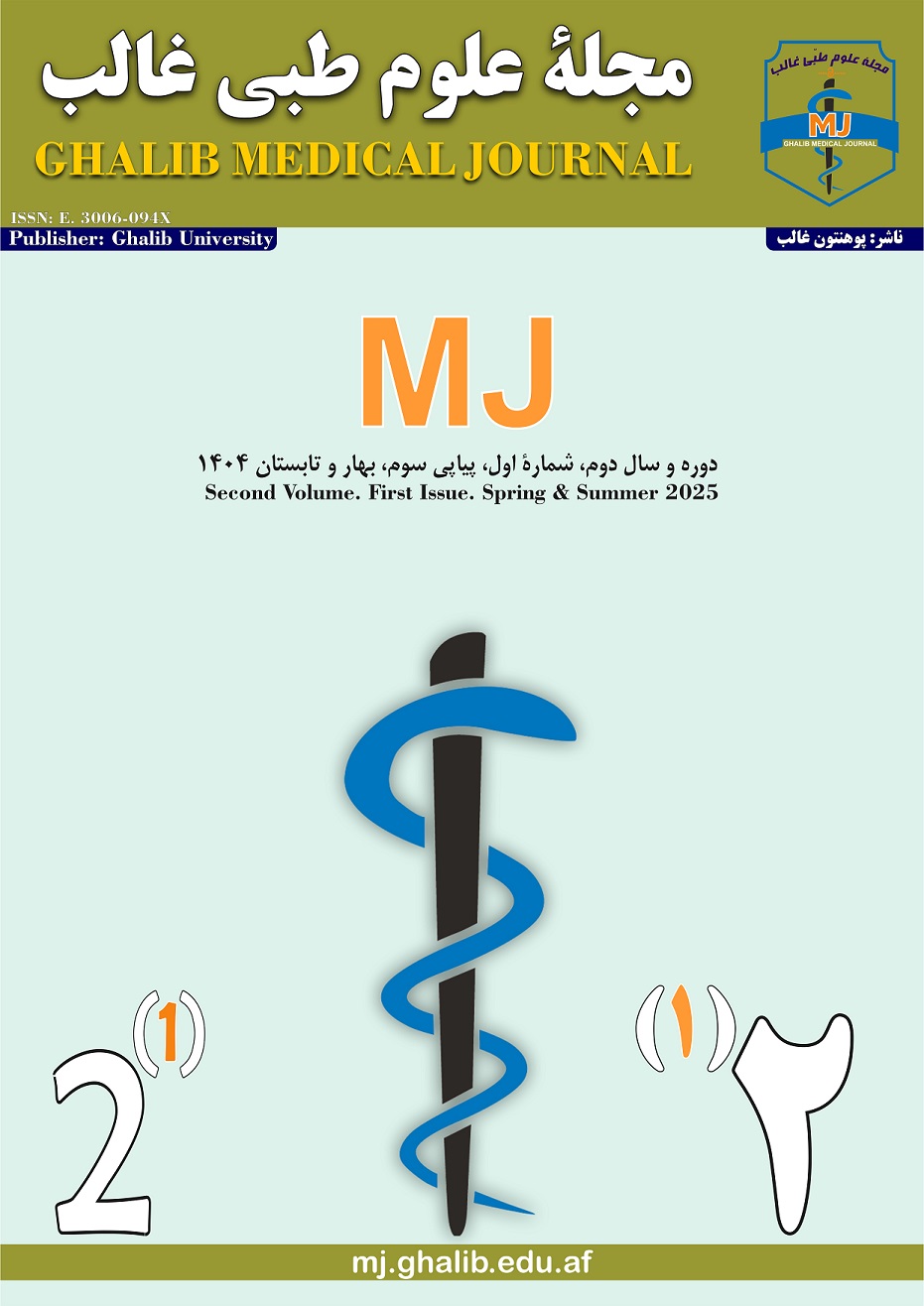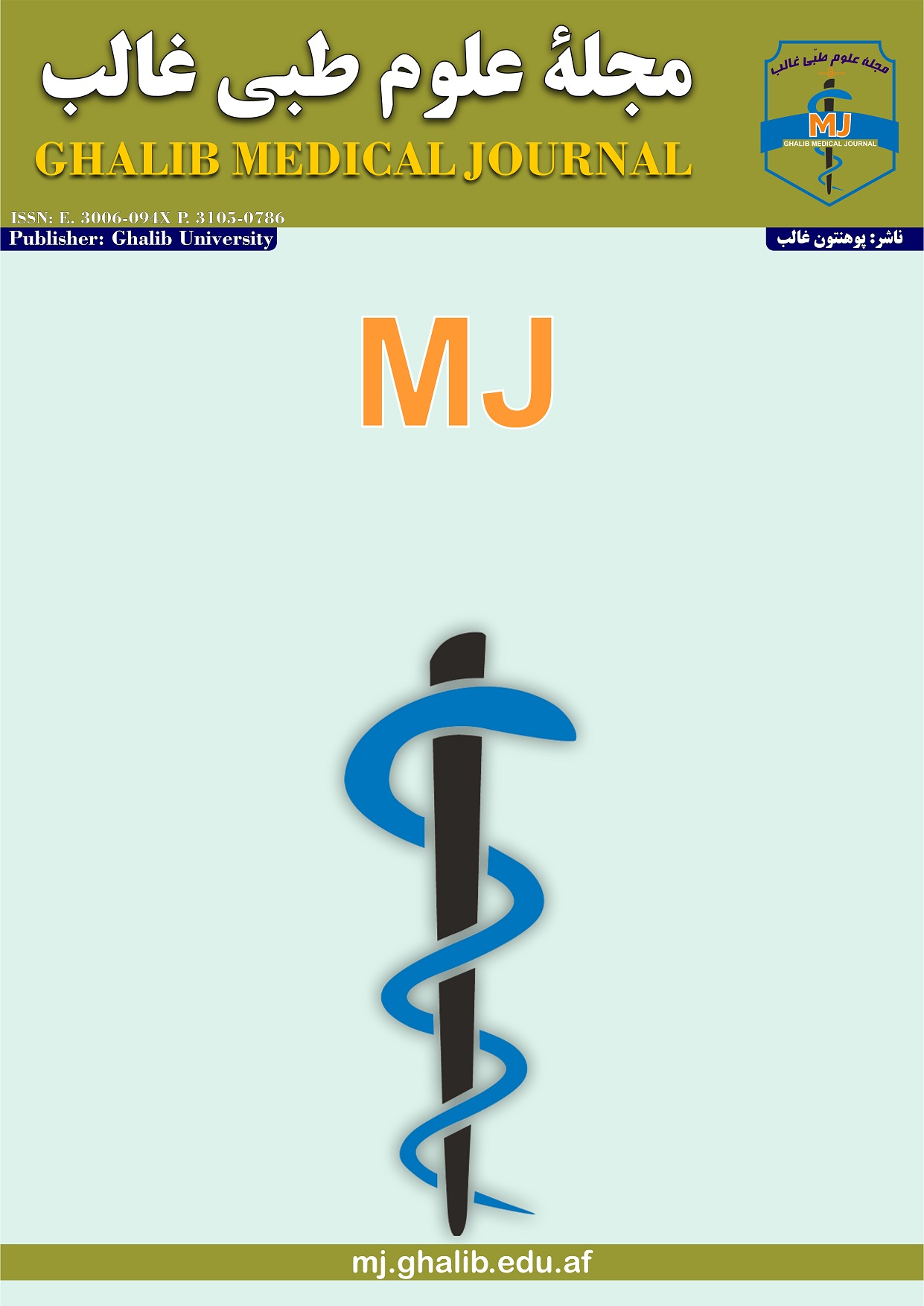رویکردهای بیوشیمیایی اخیر در درمان سرطان: یک مطالعه مروری
DOI::
https://doi.org/10.58342/ghalibMj.V.2.I.1.12واژهگانِ کلیدی:
درمان سرطان، درمان بیوشیمیایی، کریسپر، نانودارو، مهارکنندههای هدفمند، درمانهای RNAچکیده
زمینه و هدف: پیشرفتهای اخیر در حوزه بیوشیمی بهطور چشمگیری چشمانداز درمان سرطان را دگرگون کرده است. روشهای سنتی مانند شیمیدرمانی و پرتودرمانی، با وجود اثربخشی نسبی، اغلب فاقد ویژگیمندی هستند و باعث بروز سمیتهای سیستمیک میشوند. در مقابل، راهکارهای بیوشیمیایی با هدف قرار دادن دقیق مکانیسمهای مولکولی مؤثر در بروز و پیشرفت تومور، درمانهایی هدفمند و کمعارضه ارائه میدهند. این مقاله مروری به بررسی نوآوریهای نوین در درمان بیوشیمیایی سرطان میپردازد؛ با تمرکز بر مکانیسمها، پتانسیل بالینی و چالشهای مرتبط با آنها.
روش بررسی: مطالعهای جامع بر روی مقالات علمی اخیر انجام شد که موضوعاتی مانند مهارکنندههای مولکولی هدفمند، درمانهای آنزیمی، فناوریهای ویرایش ژن نظیر (CRISPR-Cas) ، درمانهای مبتنی بر RNA، بازبرنامهریزی متابولیکی، و سامانههای نانوفناورانه در رسانش دارو را پوشش میدهد.
یافتهها: رویکردهای نوین بیوشیمیایی در درمان سرطان توانستهاند دقت درمانی را افزایش، عوارض جانبی را کاهش، و نتایج درمانی بیماران را بهبود بخشند. بهویژه، ویرایش ژنی مبتنی برCRISPR ، خاموشسازی ژنهای سرطانی با استفاده ازsiRNA و نانوذرات چندکاره برای رسانش هدفمند دارو، افقهای نوینی را در انکولوژی دقیق گشودهاند.
نتیجهگیری: درمانهای بیوشیمیایی در حال تبدیل انکولوژی به دانشی فردمحور و کمتهاجمی هستند. با اینکه چالشهایی نظیر ناهمگونی توموری، محدودیتهای رسانش، اثرات ناخواسته و هزینههای بالا همچنان وجود دارند، پژوهشهای در حال پیشرفت و تلفیق میانرشتهای نویدبخش موفقیتهای بالینی در آینده نزدیک خواهند بود.
مراجع
Porta, C., Paglino, C., & Mosca, A. (2014). Targeting PI3K/Akt/mTOR Signaling in Cancer. Frontiers in Oncology, 4, 64. https://doi.org/10.3389/fonc.2014.00064
Roskoski, R. (2012). ERK1/2 MAP kinases: structure, function, and regulation. Pharmacological Research, 66(2), 105–143. https://doi.org/10.1016/j.phrs.2012.04.005
Vihinen, P., & Kähäri, V. M. (2002). Matrix metalloproteinases in cancer: Prognostic markers and therapeutic targets. International Journal of Cancer, 99(2), 157–166. https://doi.org/10.1002/ijc.10339
Warburg, O. (1956). On the origin of cancer cells. Science, 123(3191), 309–314. https://doi.org/10.1126/science.123.3191.309
Yarden, Y., & Pines, G. (2012). The ERBB network: at last, cancer therapy meets systems biology. Nature Reviews Cancer, 12(8), 553–563. https://doi.org/10.1038/nrc3309
Falkenberg, K. J., & Johnstone, R. W. (2014). Histone deacetylases and their inhibitors in cancer, neurological diseases and immune disorders. Nature Reviews Drug Discovery, 13(9), 673–691. https://doi.org/10.1038/nrd4360
Lord, C. J., & Ashworth, A. (2017). PARP inhibitors: Synthetic lethality in the clinic. Science, 355(6330), 1152–1158. https://doi.org/10.1126/science.aam7344
Senter, P. D., & Springer, C. J. (2001). Selective activation of anticancer prodrugs by monoclonal antibody-enzyme conjugates. Advances in Drug Delivery Reviews, 53(3), 247–264. https://doi.org/10.1016/S0169-409X(01)00203-6
Greco, O., & Dachs, G. U. (2001). Gene directed enzyme prodrug therapy: a review of enzyme/prodrug combinations, tumor-targeting strategies and therapeutic outcomes. Journal of Gene Medicine, 3(6), 299–310. https://doi.org/10.1002/jgm.193
Ganapathy-Kanniappan, S., & Geschwind, J. F. H. (2013). Tumor glycolysis as a target for cancer therapy: progress and prospects. Molecular Cancer, 12, 152. https://doi.org/10.1186/1476-4598-12-152
Xie, H. et al. (2014). LDHA inhibition in human pancreatic cancer cells leads to growth inhibition and enhanced sensitivity to gemcitabine. Oncotarget, 5(20), 8660–8670. https://doi.org/10.18632/oncotarget.2400
Gross, M. I. et al. (2014). Antitumor activity of the glutaminase inhibitor CB-839 in triple-negative breast cancer. Molecular Cancer Therapeutics, 13(4), 890–901. https://doi.org/10.1158/1535-7163.MCT-13-0793
Menendez, J. A., & Lupu, R. (2007). Fatty acid synthase and the lipogenic phenotype in cancer pathogenesis. Nature Reviews Cancer, 7(10), 763–777. https://doi.org/10.1038/nrc2222
Svensson, R. U. et al. (2016). Inhibition of acetyl-CoA carboxylase suppresses fatty acid synthesis and tumor growth. Cancer Cell, 29(6), 807–823. https://doi.org/10.1016/j.ccell.2016.05.002
Stein, E. M. et al. (2017). Enasidenib in mutant IDH2 relapsed or refractory acute myeloid leukemia. Blood, 130(6), 722–731. https://doi.org/10.1182/blood-2017-04-779405
Schröder, F. H. et al. (2009). Screening and prostate-cancer mortality in a randomized European study. New England Journal of Medicine, 360(13), 1320–1328. https://doi.org/10.1056/NEJMoa0810084
Trevisani, F. et al. (2001). Serum alpha-fetoprotein for diagnosis of hepatocellular carcinoma in patients with chronic liver disease: influence of HCV infection and liver disease severity. British Journal of Cancer, 85(6), 818–824. https://doi.org/10.1054/bjoc.2001.1996
Jacobs, I. et al. (1993). A risk of malignancy index incorporating CA 125, ultrasound and menopausal status for the accurate preoperative diagnosis of ovarian cancer. British Journal of Obstetrics and Gynaecology, 100(10), 927–931. https://doi.org/10.1111/j.1471-0528.1993.tb14239.x
Slamon, D. J. et al. (2001). Use of chemotherapy plus a monoclonal antibody against HER2 for metastatic breast cancer that overexpresses HER2. New England Journal of Medicine, 344(11), 783–792. https://doi.org/10.1056/NEJM200103153441101
Karapetis, C. S. et al. (2008). K-ras mutations and benefit from cetuximab in advanced colorectal cancer. New England Journal of Medicine, 359(17), 1757–1765. https://doi.org/10.1056/NEJMoa0804385
Early Breast Cancer Trialists' Collaborative Group (EBCTCG). (2011). Relevance of breast cancer hormone receptors and other factors to the efficacy of adjuvant tamoxifen: patient-level meta-analysis of randomized trials. Lancet, 378(9793), 771–784. https://doi.org/10.1016/S0140-6736(11)60993-8
Garon, E. B. et al. (2015). Pembrolizumab for the treatment of non–small-cell lung cancer. New England Journal of Medicine, 372(21), 2018–2028. https://doi.org/10.1056/NEJMoa1501824
Druker, B. J. et al. (2001). Efficacy and safety of a specific inhibitor of the BCR-ABL tyrosine kinase in chronic myeloid leukemia. New England Journal of Medicine, 344(14), 1031–1037. https://doi.org/10.1056/NEJM200104053441401
Robson, M. et al. (2017). Olaparib for metastatic breast cancer in patients with a germline BRCA mutation. New England Journal of Medicine, 377(6), 523–533. https://doi.org/10.1056/NEJMoa1706450
Bettegowda, C. et al. (2014). Detection of circulating tumor DNA in early- and late-stage human malignancies. Science Translational Medicine, 6(224), 224ra24. https://doi.org/10.1126/scitranslmed.3007094
Zhang, W. et al. (2015). Exosomes in cancer: small particle, big player. Journal of Hematology & Oncology, 8(1), 83. https://doi.org/10.1186/s13045-015-0181-x
Lu, Y. et al. (2020). Safety and feasibility of CRISPR-edited T cells in patients with refractory non-small-cell lung cancer. Nature Medicine, 26(5), 732–740. https://doi.org/10.1038/s41591-020-0840-5
Liu, Y. et al. (2019). CRISPR/Cas9-mediated gene editing of KRAS in colorectal cancer cells inhibits tumor growth. Biochemical and Biophysical Research Communications, 548, 85–92. https://doi.org/10.1016/j.bbrc.2021.07.010
Li, J. et al. (2017). Targeting BRAF mutations in melanoma using CRISPR-Cas9. Cancer Letters, 395, 19–26. https://doi.org/10.1016/j.canlet.2017.02.015
Haapaniemi, E. et al. (2018). CRISPR–Cas9 genome editing induces a p53-mediated DNA damage response. Nature Medicine, 24(7), 927–930. https://doi.org/10.1038/s41591-018-0049-z
Jinek, M. et al. (2012). A programmable dual-RNA-guided DNA endonuclease in adaptive bacterial immunity. Science, 337(6096), 816–821. https://doi.org/10.1126/science.1225829
Shalem, O. et al. (2014). Genome-scale CRISPR-Cas9 knockout screening in human cells. Science, 343(6166), 84–87. https://doi.org/10.1126/science.1247005
Lino, C. A. et al. (2018). Delivering CRISPR: a review of the challenges and approaches. Drug Delivery, 25(1), 1234–1257. https://doi.org/10.1080/10717544.2018.1474964
Barenholz, Y. (2012). Doxil®—the first FDA-approved nano-drug: lessons learned. Journal of Controlled Release, 160(2), 117–134. https://doi.org/10.1016/j.jconrel.2012.03.020
Allen, T. M., & Cullis, P. R. (2013). Liposomal drug delivery systems: from concept to clinical applications. Advanced Drug Delivery Reviews, 65(1), 36–48. https://doi.org/10.1016/j.addr.2012.09.037
Danhier, F. et al. (2012). PLGA-based nanoparticles: an overview of biomedical applications. Journal of Controlled Release, 161(2), 505–522. https://doi.org/10.1016/j.jconrel.2012.01.043
Govender, T. et al. (2000). PLGA nanoparticles for drug delivery: a review of recent advances. Critical Reviews in Therapeutic Drug Carrier Systems, 17(2), 137–185.
Dreaden, E. C. et al. (2012). The golden age: gold nanoparticles for biomedicine. Chemical Society Reviews, 41(7), 2740–2779. https://doi.org/10.1039/C1CS15237H
Laurent, S. et al. (2011). Magnetic iron oxide nanoparticles: synthesis, stabilization, vectorization, physicochemical characterizations, and biological applications. Chemical Reviews, 111(9), 7783–7813. https://doi.org/10.1021/cr200379h
Ramasamy, T. et al. (2014). Smart polymeric nanoplatforms for cancer therapy: recent advances and future perspectives. Acta Pharmaceutica Sinica B, 4(3), 197–217. https://doi.org/10.1016/j.apsb.2014.04.005
Needham, D. et al. (2000). Temperature-sensitive liposomes for the delivery of doxorubicin: clinical implications. Advanced Drug Delivery Reviews, 53(3), 285–305. https://doi.org/10.1016/S0169-409X(01)00234-7
Vader, P. et al. (2016). Extracellular vesicles for drug delivery. Advanced Drug Delivery Reviews, 106, 148–156. https://doi.org/10.1016/j.addr.2016.02.006
Verma, S. et al. (2012). Trastuzumab emtansine for HER2-positive advanced breast cancer. New England Journal of Medicine, 367(19), 1783–1791. https://doi.org/10.1056/NEJMoa1209124
Dagogo-Jack, I. & Shaw, A. T. (2018). Tumor heterogeneity and resistance to cancer therapies. Nature Reviews Clinical Oncology, 15(2), 81–94. https://doi.org/10.1038/nrclinonc.2017.166
Blanco, E. et al. (2015). Principles of nanoparticle design for overcoming biological barriers to drug delivery. Nature Biotechnology, 33(9), 941–951. https://doi.org/10.1038/nbt.3330
Charlesworth, C. T. et al. (2019). Identification of preexisting adaptive immunity to Cas9 proteins in humans. Nature Medicine, 25(2), 249–254. https://doi.org/10.1038/s41591-018-0326-x
Prasad, V. et al. (2018). The high price of anticancer drugs: origins, implications, barriers, solutions. Nature Reviews Clinical Oncology, 15(6), 381–394. https://doi.org/10.1038/s41571-018-0007-z
Hood, L. & Friend, S. H. (2011). Predictive, personalized, preventive, participatory (P4) cancer medicine. Nature Reviews Clinical Oncology, 8(3), 184–187. https://doi.org/10.1038/nrclinonc.2010.227
Ogretmen B. Sphingolipid metabolism in cancer signalling and therapy. Nature Reviews Cancer. 2018;18(1):33–50. https://doi.org/10.1038/nrc.2017.96
Saddoughi SA, Ogretmen B. Diverse functions of ceramide in cancer cell death and proliferation. Advances in Cancer Research. 2020;148:1–39. https://doi.org/10.1016/bs.acr.2020.04.002
Pyne NJ, Pyne S. Sphingosine 1-phosphate and cancer. Nature Reviews Cancer. 2022;22(6):346–361. https://doi.org/10.1038/s41568-022-00453-6
Downloads
چاپ شده
Versions
- 2025-05-14 (2)
- 2025-04-19 (1)
ارجاع به مقاله
شماره
نوع مقاله
مجوز
حق نشر 2025 نصیراحمد ابراهیمی, خواجه جمیل احمد جامی, محمداحسان صالحی

این پروژه تحت مجوز بین المللی Creative Commons Attribution 4.0 می باشد.










